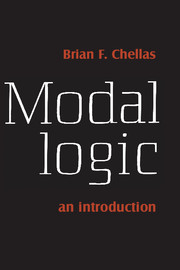5 - Determination and decidability for normal systems
Published online by Cambridge University Press: 05 June 2012
Summary
In this chapter we present and prove a number of determination theorems for normal modal logics with respect to classes of standard models. Section 5.1 contains the basic theorem for the soundness of such systems and a proof that the fifteen systems on the diagram in figure 4.1 are all distinct. In section 5.2 we return briefly to the topic of modalities in normal systems. In section 5.3 we define the idea of a canonical standard model for a normal system and prove some fundamental theorems about completeness. Section 5.4 contains determination theorems for the logics in figure 4.1, including a theorem to the effect that the system S5 is determined by the class of models of the sort described in chapter 1. In section 5.5 we generalize the ideas in sections 5.1 and 5.3 to obtain a very large class of determination results in one fell swoop, by proving that the system KGk,l,m,n is determined by the class of k,l,m,n-incestual models. Finally, in section 5.6 we prove the decidability of the fifteen systems in figure 4.1.
Soundness
The following theorem provides the basis for proofs of soundness for normal modal logics, with respect to classes of standard models.
Theorem 5.1. Let S1, …, Snbe schemas valid respectively in classes of standard models C1, …, Cn. Then the system of modal logic KS1 … Sn is sound with respect to the class C1 ∩ … ∩ Cn.
- Type
- Chapter
- Information
- Modal LogicAn Introduction, pp. 162 - 189Publisher: Cambridge University PressPrint publication year: 1980



